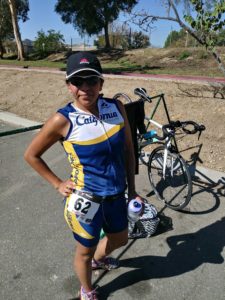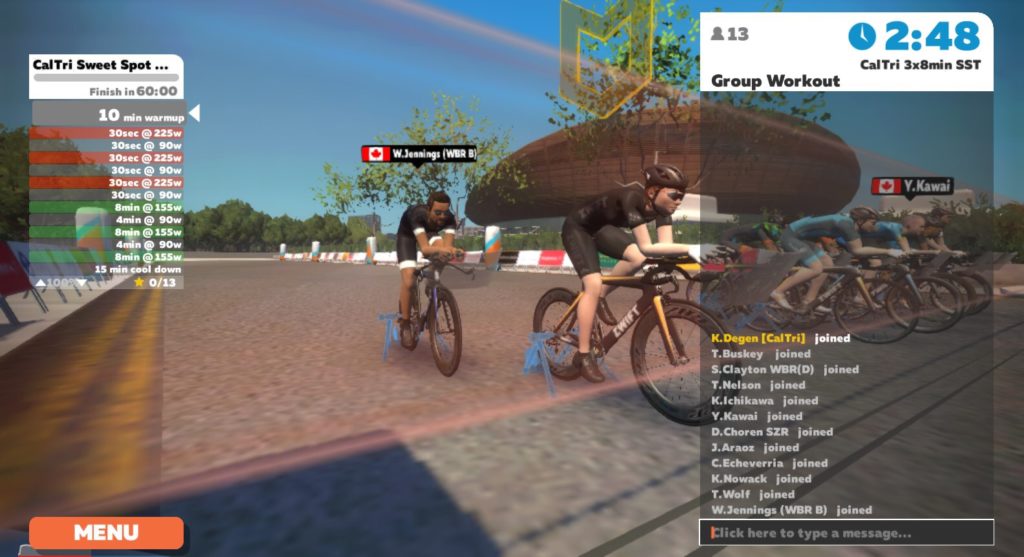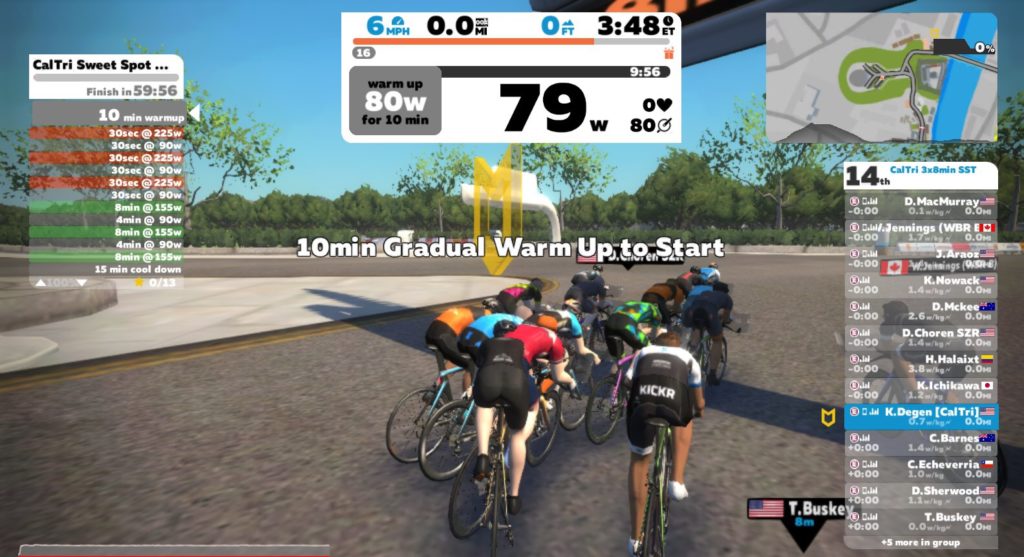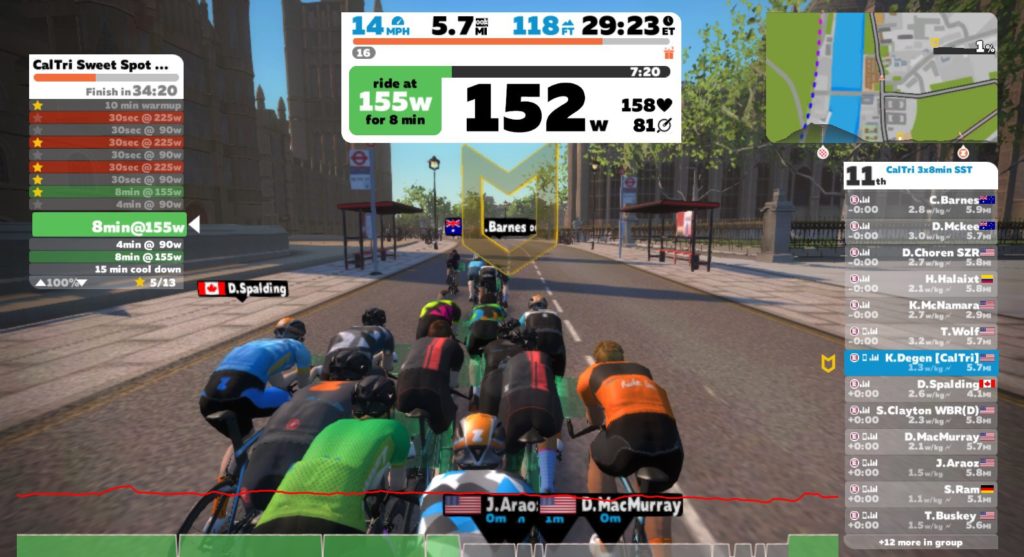Last Call for Baldy Beast on July 4th
The Baldy Beast Epic Ride is less than one week away! If you haven’t signed up for it yet, what are you waiting for?
Three options to choose from, riding as little as 27 miles or as many as 70. Plus, most of the route is closed to cars, meaning you have the opportunity to try riding with your eyes closed, using echolocation like that guy in the TED Talks (but seriously, don’t do that!).
Here’s what you need to do:
– Register for Baldy Beast here.
– Wear a CalTri kit, jersey, or tri top (or even a running singlet). If you’ve already signed up and have an extra jersey or tri top you’re willing to lend out, please bring it.
– Bring a couple of water bottles. There doesn’t even have to be water in them. We will supply water and Myoplex, our electrolyte sponsor. If you’re doing Route #1, please bring some nutrition, gels, blocks, etc., as there won’t be a SAG stop for you (due to the whole “no cars” thing).
– Bring a good attitude, which I know you’ll have because CalTri people are super nice, AND we’ll be riding bikes, so what’s to be upset about?
– If you need more details, check out the Baldy Beast Epic Ride page.
Photo by Tommy Lisbin on Unsplash
Baldy Beast
Three weeks from today, a group of patriotic triathletes will celebrate the birth of our country by donning blue, white, and gold lycra and riding their bicycles from Azusa (and remember – you can’t spell Azusa without U-S-A, unless you spell it incorrectly) to Mount Baldy. July 4th is Baldy Beast.
This is a ride for EVERYONE. You can ride as much as 68 miles with 8200 feet of climbing, to as little as 27 miles, downhill, both ways (I’m lying; there’s 3000 feet of climbing, but for a triathlete like you, it will feel like downhill both ways), to anything in between. You can ride GRR (I’m not angry; that’s just an abbreviation for Glendora Ride Road), GMR, over to Baldy Village, or up to the ski lifts, one of the most difficult and iconic climbs in California.
Don’t like traffic? You’re in luck. The roads are closed to vehicles along most of the route. Don’t like riding? What’s wrong with you (sorry, that was judgmental)?! Over 75% of every triathlon is spent on a bike. The more you ride, the more you’ll love to ride, the more comfortable you’ll be for three quarters of your next tri.
All you need to bring is a bike, a CalTri jersey or tri top, and a lot of moxie (look it up; it’s a word your grandparents used to use). Sign up on the CalTri calendar or on the Epic Rides page.
Still don’t want to ride? Volunteer. We need someone to drive the SAG vehicle, and someone to be our photographer. Volunteering for one Epic Ride gets you a whole year of Epic Rides for free.
See you on the 4th!
Great Western Loop & Honey Springs Epic Ride Recap
Twenty-ish riders left the parking lot at Jamacha Road and Willow Glen, and after a couple of flat miles, headed straight uphill for the next 15 miles. It was a beautiful day and a great group of riders who rode the Great Western Loop. Five of the riders — the Honey Springs Five — chose to add fourteen miles to their day. You’d be hard-pressed to find something more pointless than riding down a hill, only to turn around at the bottom and ride right back up. But that’s what these five riders did. Then back onto the loop for what was mostly a descent, but California being what it is, why not throw in a 10% gradient near the end, just to remind you that riding a bike, although super fun, is hard work as well.
Big thanks to Maya who organized the route and shared SAG duties with yours truly when the SAG volunteer couldn’t make it. Also mad props (that’s what the kids fifteen years ago used to say, right?) to the OC chapter who showed up in force to make the ride great.
Next up is Baldy Beast on the 4th of July. Lots of options for riders of all abilities. I will post more details soon, but why wait? Sign up on the Epic Rides page or on the CalTri calendar.
Heart of San Francisco: Epic Ride #4 Recap
Yesterday was California Triathlon’s first ever Epic Ride in San Francisco, and if I have any say in it, it won’t be our last. The fact that I don’t have any say in it shouldn’t detract from a magical ride in a beautiful city. One minute you’re riding along the waterfront, then you make a right turn and you’re climbing up a 20% gradient, then back through a park on a flat road. We rode around the Presidio, across the Golden Gate Bridge (lengthwise; width wise would have been challenging, but not as much fun), through Sausalito, Marin City, Mill Valley, and Tiburon.
Special thanks to Sara, who designed the original route, and Jonathan, who added the Marin County loop and provided SAG. Also thanks to Michael, who provided photography. Major props to Anna and Megan, who represented San Francisco (even though Megan just moved there from LA), as well as Marek, Violetta, and Gregory, who came up from SoCal. They made the drive to make the ride.
Next up is June 9th in San Diego. We have a lovely 60 mile ride around one of the most beautiful cities in the country. Sign up early and often. Or late and once. It doesn’t really matter. It’s the “sign up” part that counts.
Coming up on July 21, only two and a half weeks after our Mount Baldy ride, we’ve scheduled another Northern California ride — Lake Tahoe Treat. Who wouldn’t want to ride around beautiful Lake Tahoe? Apparently, all but six of you. That’ll teach you to assume a question is rhetorical. So here’s what we’re going to do. We’re going to take our Angels & Demons ride and turn it on its head. May I present to you:
Demons & Angels
We leave from the Anaheim Amtrak station, only this time we drop our bikes off, board the train, and take it to Solana Beach, where we pick up our bikes and ride north through Oceanside, Camp Pendleton, Laguna, and back to Anaheim, where our cars are waiting to hold our bikes while we slip into JT Schmid’s for food and some well-earned libations.
More details to come, but save the date. It’s going to be a great one.
Upper Big T with Mt Wilson
April 14 – Upper Big T with Mt Wilson (72 mi)
Start: TBA
Time: TBA
Ride Route: RideWithGPS
Elevation: 8,400 ft
Difficulty (1-5) = 4
THE RIDE. This year’s SGV led ride is the iconic Big T (Big Tujunga) Ride! After the relative flat ride of Angels & Demons, Big T is going to take you up into the clouds. There will be three different options depending on your climbing legs and desire for pie (more on that in a second).
THE ROUTE. The Big T Epic Ride will roll out from Pasadena with a relatively easy 16 miles of ascent broken up with a fast downhill before the real fun begins. We’ll regroup at a 7-11 so folks can make sure they have their water topped off and can use the bathrooms, then we’ll head onto the climb. Just beyond mile 28 will be two options. You can cut it a little short and head right at the fork which has just a little bit more climbing before you hit the Angeles Crest Highway at Clear Creek Ranger Station. From here, just head down the Crest Highway for an awesome 9 mile descent with gentle curves and some pretty decent pavement. If you’re looking for some more challenge though, you’ll turn left at the fork and continue to Upper Big T where you’ll climb an additional 1,400 feet in about 14 miles before you connect with the Angeles Crest Highway. Another 4 miles and you’ll arrive at Red Box. This is where you will want to make another fateful decision. Head down that awesome descent towards Pasadena and home, or head for pie. Pie? That’s your reward for climbing an additional 1,000 feet over 5 miles. The Cosmic Café is a popular hiker and cyclist stop where you can pick up a soda, bag of chips, or my favorite, apple pie a la mode. The dessert will be a welcome addition as you head your bike down for a 26 mile, nearly 5,000 foot descent back into Pasadena.
Mile 0-16: Pasadena up through Montrose and down to Sunland.
Mile 16-28.5 The lower Big T Climb which hits the Clear Creek Ranger Station at mile 32.5 before the descent back to Pasadena. This route is 49 miles with 4,800 feet of climbing.
Mile 28.5-42 The Upper Big T Climb hits the Angeles Crest Highway at 4,600 feet up through lovely mountains and meadows.
Mile 42-46.5 Rolling hills to the Red Box Gap.
Mile 46.5-67 The fast descent down into Pasadena. This option is 67 miles and 7,300 feet of climbing.
Mile 46.5-51.3 The Mt. Wilson Climb to Pie A La Mode! Amazing views over the San Gabriel Valley and Los Angeles. Mt Wilson is the site of one of the most storied Observatories in the world. It is home to the world’s first permanent solar telescope and is where Edwin Hubble proved that there were multiple galaxies, that the universe is expanding and Fritz Zwicky found the evidence for Dark Matter. And did I mention the home made pie?!?
Mile 51.3-77: From here it is a 26 mile fun ride back to your car. This option is 77 miles and 8,400 feet of climbing
Ride for the comradery, climb for the pie!
Introducing Cal Tri – San Joaquin Valley
Introducing California Triathlon – San Joaquin Valley! Our newest chapter, based out of Bakersfield, exists to promote group training and the triathlon habit across the area that lies south of the Sacramento–San Joaquin River Delta, including all of Kings County; a majority of Fresno, Merced, Stanislaus counties; segments of Madera and Tulare counties—and a majority of Kern County. Bakersfield, Clovis, Delano, Madera, McFarland, Merced, Modesto, Strockton, Tehachapi, Tulare, Visalia… too many towns and cities to possibly list them all. Let’s take advantage of the places across our great region where we can swim, bike, and run!
We are just getting started but we have big plans for 2018 and beyond! Whether you are a seasoned veteran, a beginner, an aspiring triathlete, or simply tri-curious, we encourage you to join us (membership is always free!) and let us help you accomplish your goals!
Our chapter is led by Alejandra “Alex” Perez whose determination is matched only by her enthusiasm. She learned about triathlon and what to do before her first race by watching youtube videos. Eventually she found California Triathlon. Now she is eager to share her knowledge and experience with others, support our mission, and help grow the sport in her part of the Golden State.
Hello Eve ryone, I’m Alex, formerly from Orange County, currently living in the city of Bakersfield, California,
ryone, I’m Alex, formerly from Orange County, currently living in the city of Bakersfield, California,
I am very thankful and very excited for this opportunity to be part of California Triathlon and lead a new chapter.
What brought me to the California Triathlon family is their passion and willingness to help other triathletes in the community by organizing training and resources to make the sport more accessible. I love our volunteer leadership’s organization, commitment, passion, humbleness, skills, and their willingness to give back to our community.
A little bit about my background: I too have a love and passion for Sports. I have a background in international dance, Body Building, CrossFit, kickboxing, running, swimming, cycling, yoga, and polga fitness. What I love about triathlons is the endurance in all three disciplines. requiring continuous and sequential effort to complete all three sports. This makes it challenging and fun.
I call our San Joaquin Valley “the heart of California”; as it is right in the center of California forming 7 counties. As a new chapter our goal is to start training in all 3 disciplines. We are currently working on starting our swimming clinic in the city of Bakersfield, soon we will be sending invitations with start date. As we start the new year, we are planning on adding more activities to our calendar as we spread the word and organize more activities suitable for everyone. Our San Joaquin Valley is blessed with many trails perfect for cycling and running! I’m anxious to meet all of our triathletes from our San Joaquin Valley Chapter at our upcoming activities!
Would you like to train with us? Do you have questions? Want to get involved? Please contact alex@californiatriathlon.org
CalTri Wednesday Night Zwift Workout
WEDNESDAY, 9:15PM EST/6:15PM PST – CAL TRI WEEKLY RIDE ON ZWIFT
Join California Triathlon for a 60 minute Sweet Spot (SST) workout on Zwift to build a stronger aerobic base and increasing your lactate threshold and VO2 max. It will begin with a 10 minute gradual warm up which leads into 3×30 seconds spin ups to make sure the legs are ready to work. The main set of the workout will be 3×8 minutes at 85% of your FTP and then conclude with a 15 minute cool down. Kim Degen, workout creator and leader, will be leading you through this time effective workout.
Athletes will line up in the staging area and once the event starts, workout mode begins. Everyone stays together regardless of their power output. No more being dropped within minutes of joining the ride/workout. Since the workout is based on your personal FTP, it is highly recommended that you do a FTP test to determine your correct functional threshold power.
What do you need to join:
- Bike
- Bike Trainer
- Smart Trainer
- Classic Trainer with speed sensor
- Device to run Zwift (Computer, iPhone, iPad, AppleTV)
- Zwift Account
- You can try Zwift for 7 days free before you subscribe to their monthly service.



2017 GRAND PRIX California Results Posted
 The 2017 GRAND PRIX California concluded on October 15 with Legends [LA] and Life Time San Diego. The GRAND PRIX California is a competitive series of 25 races in the LA, San Francisco, San Diego and Orange County areas. The GRAND PRIX California encourages athletes to race more frequently by providing athlete support and special deals. Athletes compete for both pride and athletes competing in 3 races eligible for end of the season prizes.
The 2017 GRAND PRIX California concluded on October 15 with Legends [LA] and Life Time San Diego. The GRAND PRIX California is a competitive series of 25 races in the LA, San Francisco, San Diego and Orange County areas. The GRAND PRIX California encourages athletes to race more frequently by providing athlete support and special deals. Athletes compete for both pride and athletes competing in 3 races eligible for end of the season prizes.
- 7,782 athletes participated in select 2017 GRAND PRIX California races
- 421 California Triathlon athletes competed for both pride and prizes.
- The Top 10 Overall Men and Top 10 Overall Women will receive a beautiful award to recognize their accomplishment
- 72 Age Group Winners will receive:
- 1st Place – A $50 Performance Gift Card, the France 1 XX2i Sunglasses Gift Certificate and a XTERRA Wetsuits Transition Bag
- 2nd Place – The France 1 XX2i Sunglasses Gift Certificate and XTERRA Swim Gear Bag!
- 3rd Place – The France 1 XX2i Sunglasses Gift Certificate and XTERRA Changing Mat!
- Mar 11 – TriEvents 1
- Apr 8 – TriEvents 2
- May 12 – TriEvents 3
- Jun 3 – OC Tri
- Jun 23 – Big Bear
- Sep 9 – Pacific Coast
- Oct 6 – Legends
- Oct 27 – Trick or Tri
Decline in U.S. Long-Course Triathlon Finishers Continues Through 2017
Finisher numbers in U.S. long-course triathlons are on a dramatic decline.
The graphic below illustrates the change in number of finishers at Ironman 70.3 races year-over-year (YoY) from 2016 to 2017 . The map includes Canada and Mexico to show that finisher numbers in U.S. neighboring countries are actually growing (e.g. Monterrey, Cozumel, and Canada). Meanwhile, U.S. Ironman 70.3 participation dropping with only a few exceptions (e.g. Santa Rosa, Boulder).
Across the board for Ironman 70.3 races, participation is down 9% in the U.S.

Why is this happening? WTC is a huge corporation that takes years to change course (on the other hand, grassroots triathlon races are relatively small operations that can adapt quickly). Here are two areas where Ironman can be beat:
- COST. The average Ironman household income is $247,000 / year. Triathlon can be an expensive sport, but Ironman charges a premium to register for its branded races. Race registration cost is an area where grassroots races can undercut Ironman and still be successful if they find ways to provide a high-quality race experience and bolster registrant numbers.
- ACCESSIBILITY. Long-course racing is a demanding endeavor. Ironman is spread too thin to offer comprehensive coaching that leads to successful completion of its races. Grassroots races, on the other hand, are uniquely poised to partner with volunteer organizations. Those volunteers provide high-quality coaching that leads directly to successful completion of the target race, leaving athletes happy and coming back year after year.
There’s more to the story though. Read on to find out what’s happening with grassroots triathlon, how Ironman is responding to the drop in triathlon participation, and why Ironman’s response is a big deal for the future of the sport.
Are Grassroots Triathlon Races In Decline Too?
Grassroots 70.3 races have also been hit by the decline in triathlete finisher numbers. Luckily these are smaller organizations, capable of adapting quickly to the changing market.
We have compiled data from U.S. non-Ironman branded 70.3 distance races YoY from 2016 and 2017. Among larger grassroots races with 200 – 700 finishers, numbers are down with only a few exceptions (e.g. REV3 Niagara Falls and Williamsburg, Door County Triathlon). Smaller grassroots 70.3 races with 1 – 200 finishers are also experiencing an overall decline, though there is considerable variability in the changes.
Across all grassroots 70.3 races, finisher numbers are down 14%.


Are All the 70.3 Athletes Graduating to the 140.6 Distance?
No. Ironman 140.6 races are not immune to the decline in participation. Of all North America Ironman 140.6 races to date in 2017, only Ironman Chattanooga has experienced robust growth, while five others have declined by 7 – 46%.

What Are the Consequences For The Future of Triathlon?
The bigger story here is that WTC is trying to compensate for the decrease in U.S. triathletes by adding races to their calendar. WTC Ironman has added 5 North America races in each of the last two years. By adding races, Ironman 70.3 participation has grown by over 6,000 finishers – despite the 9% average drop in YoY participation within existing races. That generates extra revenue for WTC, but extra problems for WTC and for triathlon as a sport.
- WTC can’t keep up with expansion. They are spreading resources thin to cover the growing number of races, so race quality suffers. This unfortunately has real world consequences like decreased course safety and inadequate aid stations.
- When new Ironman races come to town, they cut into the business that local grassroots races depend on. That’s what happened in Wisconsin when Ironman 70.3 Racine and Wisconsin were scheduled for June and July to take out Door County Triathlon’s business.
Those grassroots races and their directors are the ones that build a triathlon community. They’re the businesses that put on local sprint and olympic races throughout the year – those races where new athletes learn to love the sport. Without them, how will new triathletes learn the ropes of racing? That’s where our sport grows: from the ground up.
Without realizing it, Ironman is going to push itself out of business and take the sport of down triathlon with it. With any foresight, WTC would pump resources into growing grassroots triathlon businesses that put on sprint and olympic races. Those races are the training grounds for future Ironman athletes.
What Can You Do To Fight The Decline?
These dramatic declines in athlete finisher numbers are daunting, but grassroots triathlon races and athletes are capable of overcoming this challenge. California Triathlon suggests that grassroots race directors and athletes:
- Network with each other to share ideas that have resulted in healthy finisher numbers.
- Commit to making their races affordable, while maintaining race quality.
- Contribute to making triathlon accessible by partnering to provide high-quality coaching and mentoring.
- Promote grassroots races. When’s the last time USAT featured a grassroots race in a news article or press release? You’ve got to find other media outlets for your race.
- Choose to race affordable and accessible long-course triathlons.
Notes: This data is updated from a previous article and accurate through 10/16/17. We use median, rather than average, for U.S. and North America statistics to avoid issues with outliers. For example, IM70.3 Canada is an outlier with 171% growth, skewing the average by about 10%. We use finisher numbers for both Ironman and grassroots races as they are more reliable than registration numbers, which are often inaccurate or unavailable.
Read this if you want to run fast!

I recently had someone ask me “How can I run faster?” I have found that the best way to get faster is to do a combination of speed work and tempo runs during the week. If you are just building up your running base or getting back into running after some time off or an injury, I recommend starting out with either a speed workout OR a tempo run each week.
After about 4-6 weeks of working on your base, then you can add a speed workout and a tempo run to your weekly schedule. (So, if you are just starting to build speed – in my example below – you could alternate each week with a Speed Workout OR a Tempo Workout, then after building up your base – you can restart the plan and include BOTH a Speed Workout AND a Tempo Run each week). I want to emphasize that it is important that you don’t increase your overall running mileage by more the 10% each week – this will help to prevent injury.
For your speed work, you can do a combination of 200, 400, or 800 meter repeats with 200 to 400 meters of walking or jogging in between each set. The number of repeats can vary and build each week.
For your tempo work, you can start out with 1 mile at a certain pace and build each week increasing the number of miles that you run at a tempo pace. The tempo pace can be at a 5 or 10k pace or half-marathon/marathon pace depending on your upcoming race or goals. A tempo pace can also be a pace slightly faster than your normal run pace if you are just building your run base. These tempo paces should not be very comfortable as you start out the plan, but as you build your running fitness you will notice the tempo paces become a little easier to maintain. (Doing a tempo run in a training plan gives you a good idea of how it will feel during a race – you can practice some mental toughness during training that will help you on race day!)
You do not need a track to perform these workouts, in fact it’s a nice challenge if you can find a route with a few rolling hills…. because no race course is ever perfectly flat, right? If you do not want to mess with calculating a certain distance, or maybe you don’t have a watch that can measure distance yet – then run for a certain number of minutes – for example 1 min sprint, 1 min easy and repeat this 5 times during a workout. You can increase the number of sprinting minutes and recovery minutes each week.
I’ve included a sample build set below. I like to do my speed workouts on Tuesday and my Tempo workouts on Thursday – this also aligns with the Cal Tri FREE 70.3 race plan. https://californiatriathlon.org/coaching/training-plans/ (Please note that this example does not include any swim or bike sets or additional recovery runs that an athlete might do during the week)
Week 1 = Speed Workout – half mile warm up, 2×200 sprint with 200 jog/walk, 1×400 sprint with 200 jog/walk, half mile cool down
Tempo Workout – 1 mile warm-up jog, 1 mile at 10k Race Pace, 1 mile cool down
Week 2 = Speed Workout – half mile warm up, 4×200 sprint with 200 jog/walk, 2×400 sprint with 200 jog/walk, half mile cool down
Tempo Workout – 1 mile warm up jog, 2 miles at 10K Race Pace, 1 mile cool down
Week 3 = Speed Workout – half mile warm up, 4×400 sprint with 400 jog/walk, 1×800 sprint with 400 jog/walk, half mile cool down
Tempo Workout – 1 mile warm up jog, 3 miles at 10K Race Pace, 1 mile cool down
Week 4 = Speed Workout – half mile warm up, 6×400 sprint with 400 jog/walk, 2×800 sprint with 400 jog/walk, half mile cool down
Tempo Workout – 1 mile warm up jog, 4 miles at 10K Race Pace, 1 mile cool down
Week 5 = Speed Workout – half mile warm up, 8×400 sprint with 400 jog/walk, 2×800 sprint with 400 jog/walk, half mile cool down
Tempo Workout – 1 mile warm up jog, 5 miles at 10K Race Pace, 1 mile cool down
The combinations and possibilities are endless when it comes to bringing variety to building your speed — did I tell you how much I LOVE running?….. I could really talk about running ALL day!
-Coach Sara
